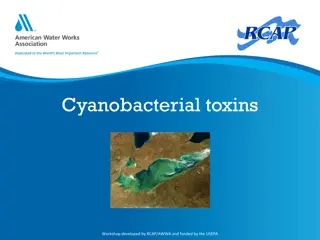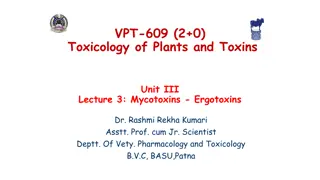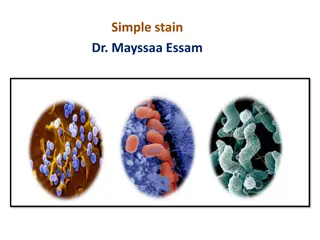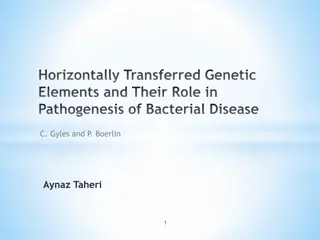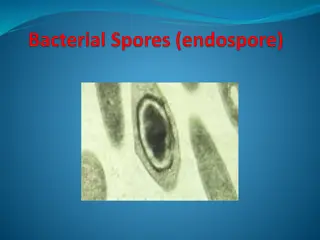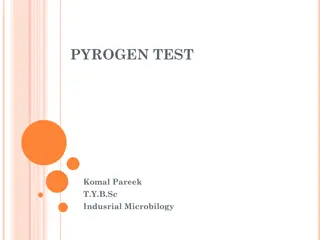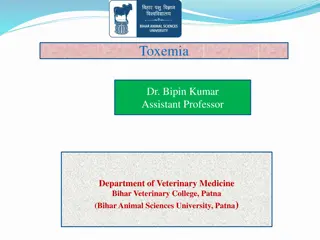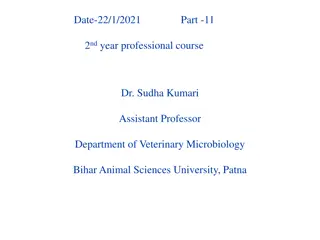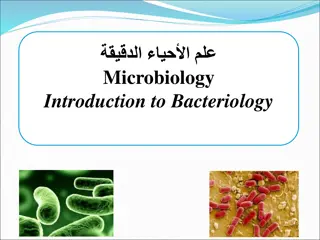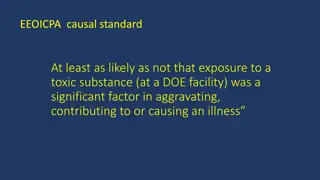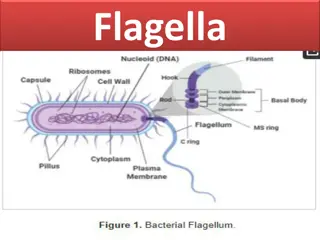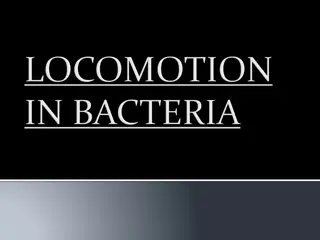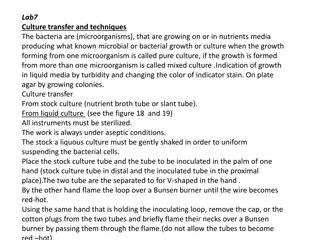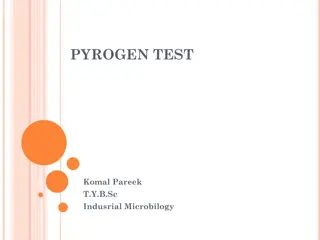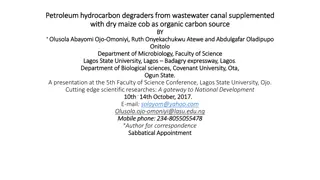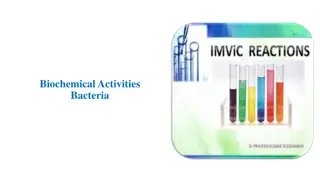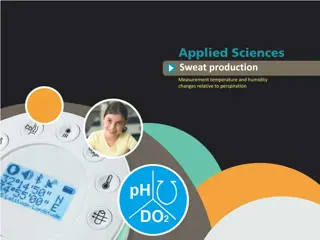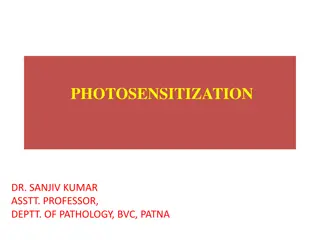Understanding Bacterial Toxins: Production, Types, and Effects
Explore the world of bacterial toxins, focusing on production mechanisms, various types such as cytotoxins and their effects on host cells. Delve into specific examples like Diphtheria Toxin caused by Corynebacterium diphtheriae, understanding its biological features and the disease it leads to.
Download Presentation

Please find below an Image/Link to download the presentation.
The content on the website is provided AS IS for your information and personal use only. It may not be sold, licensed, or shared on other websites without obtaining consent from the author. Download presentation by click this link. If you encounter any issues during the download, it is possible that the publisher has removed the file from their server.
E N D
Presentation Transcript
Microbial Toxin-BIOC 422 Lecture-5
1 1- - Bacterial Toxins Bacterial Toxins
Production of toxins (Toxigenicity) How do toxins make it into target cells: Covered topics What are Microbial Toxins I. directly inject toxins into host cells (pathogen-dependent entry) Toxicological Terms II. release AB toxins (pathogen-independent entry) intercellular survival of bacteria survive: Friends or foes? Measurement of Dose I. Avoid or Overcome Phagocytes The importance of dose and the dose response relationship II. Inhibition of Phagocytic Engulfment III. Survival Inside of phagocytes How to Measure Toxicity IV. Kill or Damage Phagocytes Routes of Exposure Two main types of bacterial toxins: I. Endotoxins II. Exotoxins EXOTOXINS Duration & Frequency of Exposure Applied Toxicology Main Characteristics Exotoxin classification 4 basic ways in which bacteria can damage a host: Exotoxin Types (General classifications): 1) Use host cell s nutrients 2) Direct damage 3) Induce hypersensitivity reactions (allergies) 4) Production of toxins (Toxigenicity) 1. Cytotoxins 2. Neurotoxins 3. Enterotoxins Exotoxin Structure Mode of action
4- Production of toxins : I. Exotoxins 1)- Cytotoxins : A cytotoxin is any substance which has a toxic effect on cells. Cytotoxins typically attack only a specific type of cell or organ, rather than an entire body. EXAMPLES: i. The best known and studied bacterial toxin. It is an exotoxin secreted by Corynebacterium diphtheria, causing Diphtheria. Diphtheria Toxin >> Diphtheria What is Corynebacterium diphtheria?
i. Diphtheria Toxin What is Corynebacterium diphtheria? Biological Features: C. diphtheriae is an aerobic gram-positive bacillus. Rod shaped Non-capsulated Non-spore-forming Non-motile (show no motion) Produces AB exotoxin The AB toxins are two-component protein complexes secreted by a number of pathogenic bacteria.
i. Diphtheria Toxin What is Diphtheria? Diphtheria is a highly-contagious disease caused by Corynebacterium diphtheriae. It is generally an upper respiratory tract illness characterized by sore throat, low-grade fever, and an adherent membrane (a pseudomembrane) on the tonsil(s), pharynx, and/or nose. A milder form of diphtheria can be limited to the skin. Diphtheria was named in 1826 and takes its name from the Greek word for leather, >>The name alludes to the leathery, sheath-like membrane that grows on the tonsils, throat, and in the nose.
Diphtheria Epidemiology: This figure shows the reported global incidence of diphtheria between 1980 and 2006. Generally, as vaccine coverage with DPT has increased, the incidence of diphtheria has decreased. However, note the spike between 1993 and 1997, attributable to a drop in vaccine coverage in new Independent States of the former Soviet Union, as explained in the text above. WHO.
Diphtheria Pathogenesis: The transfer of the gene for the formation of diphtheria toxin carried by bacteriophage (a virus that attacks and infects bacteria). The toxin causes the disease diphtheria in humans by gaining entry into the cell cytoplasm and inhibiting protein synthesis. It is produced as single polypeptide chain of 535 amino acids consisting of two subunits linked by disulfide bridges, known as an A-B toxin. A (Red) Active part: is the catalytic domain; B (yellow) is the binding domain which displays the receptor for cell attachment; T (blue) is the hydrophobic domain responsible for insertion into the endosome membrane to secure the release of A.
Diphtheria Mode of Action Mode of Action Acidification of the endocytic vesicle allows unfolding of the A and B chains exposing the hydrophobic T domain of the toxin. A component utilizes NAD as a substrate. It catalyzes the attachment of the ADP-ribose portion of NAD to elongation factor (EF-2) which inactivates its function in protein synthesis.
Diphtheria Signs and symptoms The lethal dose for humans is about 0.1 g of toxin per kg of bodyweight. A massive release of toxin into the body will likely cause lethal necrosis of the heart and liver. The respiratory form has an incubation period of two to five days and the onset of disease is usually gradual. Symptoms include : > Local infection symptoms Severe inflammatory reaction Severe swelling in back of neck Sore throat, nausea, vomiting Formation of pseudomembrane > Systemic symptoms Toxemia as toxin is absorbed from throat and carried by blood to target organs Heart and nervous system
Diphtheria Transmission: solely among humans spread by droplets, secretions & direct contact Risk Factors: 1- Poor nutrition 2- Crowded or unhealthy living conditions 3- Low vaccine coverage among infants and children 4- Immunity gaps in adults Diagnosis: The laboratory criteria for diagnosis Isolation of Corynebacterium diphtheriae from a clinical specimen; Histopathologic diagnosis of diphtheria. The clinical criteria for diagnosis Upper respiratory tract illness with sore throat; Low-grade fever; An adherent membrane of the tonsil(s), pharynx, and/or nose. .
Diphtheria Treatment: The disease may remain manageable, but in more severe cases: lymph nodes in the neck may swell, causing breathing and swallowing to become more difficult. >>People in this stage may require intubation (placing a tube in the trachea) to open a direct airway through an cut in the trachea. In addition, an increase in heart rate may cause cardiac arrest can cause paralysis in the eye, neck, throat, or respiratory muscles. >> Individuals with severe cases are put in a hospital intensive care unit (ICU) and given a diphtheria antitoxin. >> Since antitoxin does not neutralize toxin that is already bound to tissues, delaying its administration is associated with an increase in mortality risk ..Therefore, the decision to administer diphtheria antitoxin is based on clinical diagnosis, and does not have to await laboratory confirmation. Vaccine: Prevention is done by immunization with toxoid vaccine,



